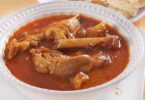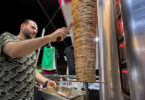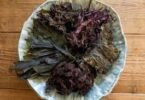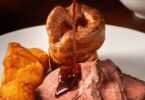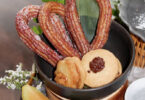Nigel Slater
There is rough-hewn, sesame-scented halva with dark chocolate, walnuts and sugared rose petals; wedges of golden baklava with layers of sweet mincemeat and buttery filo; an ice-cream glistening with candied fruit and amaretti, and glass dishes of jelly that smells of sweet orange, elderflower, pomegranate and fresh mint. A bowl of quince has been cooked till the fruit is as red as garnets and as sticky as honey. The candles are lit. The Christmas dessert table is ready.
As much as I love the traditional plum pudding with its holly sprig and crown of flames, the sumptuously layered trifle as soft and white as goose down and button-sized mince pies sparkling with sifted sugar, I like to offer more – a handful of little surprises, tiny temptations no one is expecting. This is pure fun for the cook, the day spent putting a tub of cassata in the freezer or halva in a tin; quivering jellies in the fridge, for tomorrow or the day after.
None of my Christmas extras need to be eaten the moment they are made. All will keep for a day or two and the ice-cream can stay in the freezer all Christmas, ready to slice or scoop on New Year’s Day. Scented with orange zest and almond, with vine fruits and candied citrus; dusted with chopped pistachios and rose petals or sprayed with gold, they are the essence of the season, sweetmeats with which to amuse and delight. None take very long to make, or require special equipment. Just an hour or two in which to do something special, magical, a little extra something for all who come calling.
Orange and elderflower jelly with pomegranate and mint (pictured above)
A shimmering jelly, properly made with fruit juice and lightly set with leaf gelatine, is a refreshing delight among the sweet richness of Christmas. It also comes, at least in this house, with a whole sack of nostalgia for the Christmases of my childhood. Then, we ate it with tinned mandarin oranges and maraschino cherries. Nowadays, I prefer something more tart and crunchy, such as a salad of pomegranate and mint.
Powdered gelatine and I have never been friends, but gelatine leaves give a softer and more predictable set. If you soak them in water no hotter than room temperature, the ensuing blob of gelatine is easy to lift out with your hands and drop into the lightly warmed juice, where it will dissolve with a stir or two. Any hotter and your gelatine will lose its effectiveness and be difficult to use. Among the cream and sugar, the chocolate and the icing, it is something of a quiet joy to come across a simple fruit jelly. This recipe is made in minutes.
Makes 6
leaf gelatine 10g (5 sheets)
orange juice 500ml
elderflower cordial 60ml
For the salad
pomegranate ½
mint leaves 20
caster sugar 4 tbsp
To finish
elderflower cordial 6 tbsp
Soak the gelatine leaves in a bowl of cool (but not ice cold) water, pushing the leaves under the water one at the time to prevent them from sticking.
Warm the orange juice in a saucepan, but do not let it anywhere near the boil. Remove the gelatine from the water – it should be a squishy lump – and stir it into the warm orange juice. When the gelatine has completely dissolved, stir in the 60ml of cordial and tip into a jug. Pour into glasses or small dishes – glass will help the jelly catch the light. Transfer to the fridge and leave for a good 4 hours to set.
Remove the peel from the pomegranate and separate the seeds. Make sure to remove any papery skin. Put the mint leaves and sugar in the bowl of a food processor and process till the sugar has turned green. Remove the jelly from the fridge, and flood the surface of each one with a tablespoon of elderflower cordial. Place a spoonful of the pomegranate seeds on each jelly together with some of the mint sugar. Keep any extra mint sugar in a jar for another day.
Chocolate-coated halva
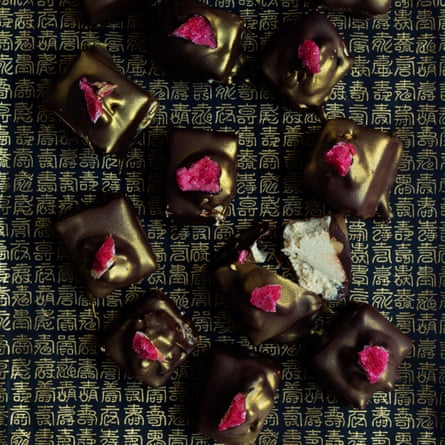
Chocolate-coated halva. Photograph: Jonathan Lovekin/The Observer
Halva, the fudge-like sesame and sugar paste, is gorgeous when coated in crisp, dark chocolate (think chocolate marzipan, only less sweet). There are many halvas, ingredients, texture and spelling, changing according to local custom. I use a plain tahini halva firm enough to cut into squares, for coating in chocolate, though a pistachio version would be good too.
Let the pieces of chocolate soften in a bowl, balanced over a pan of simmering water. As the chocolate melts, avoid the temptation to stir. Instead, just push any unmelted pieces into the liquid chocolate with the back of a spoon. Stirring can make the chocolate “seize”, as can allowing it to get too hot, so don’t let the bottom of the bowl touch the simmering water.
I used an edible gold food spray – available from cake decorating shops and sites – to decorate the finished chocolates; a frivolous festive gesture if ever there was.
Makes 14-15
dark chocolate 200g
halva 350g
walnut halves 14-15
For decoration
crystalised rose petals 14-15 pieces
gold food spray (optional)
Snap the chocolate into small pieces and place in a heatproof bowl. Put a pan of water on to boil, then lower the heat to a simmer. Place the bowl of chocolate over the water (the base of the bowl should not touch the water) and leave to melt. Let the pieces of chocolate turn to liquid, pushing them gently under the surface as they melt.
Turn the halva out on to a board and cut or break into 14-15 pieces, each weighing roughly 25g. (It is nice not to make them too uniform, different sized pieces are charming.) Put a piece of waxed paper on a cooling rack and place the halva pieces on the paper with plenty of room around each. Place a walnut half on each one. Trickle the melted chocolate over the top and sides of each piece, place a crystalised rose petal on each one and leave in a cool place to set.
Should you wish, spray each one lightly with a little gold food spray. Peel each chocolate from the paper and place on a pretty dish.
No-churn candied fruit and clementine cassata ice

No-churn candied fruit and clementine cassata ice. Photograph: Jonathan Lovekin/The Observer
A festive ice-cream for the sweet of tooth. I use the small ready-made meringues from Italian grocers and major supermarkets for this. The most suitable amaretti are the soft, cake-like ones heavy with ground almonds rather than the crisp, biscuit style. I make my own custard simply for the joy of making it, but there is no reason why you shouldn’t use a carton of ready-made, chilled custard if that is easier – just make sure it is a good one, with cream and vanilla.
Like the traditional Italian cassata on which the recipe is based, this is quite sweet, so I bring it to the table with a dish of very softly whipped cream which has a calming effect on the sugar, and a refreshing plate of peeled and sliced clementines to serve alongside.
No special equipment is needed here. The ice freezes firmly but is soft enough that you can remove scoops or slices throughout Christmas and new year, straight from the freezer.
Enough for 8-10
double cream 750ml
egg yolks 5
caster sugar 5 tbsp
soft amaretti 200g
meringues 70g, ready-made are fine
flaked almonds 50g
shelled pistachios 50g
clementines 2, peeled
candied orange and lemon peel 100g
maple syrup 125ml
To serve
whipped cream
sliced oranges or whole clementines
You will need a deep, plastic freezer tub or similar.
Bring the cream almost to the boil, in a medium-sized pan then remove from the heat.
Beat the yolks and sugar together until they are thick, then pour the warm cream over them and stir till well mixed. Wash and dry the cream saucepan, then pour the mixture back into it and place over a low to moderate heat, stirring almost continuously. When the mixture is thick enough to coat the back of your wooden spoon, pour into a chilled bowl and stir for a couple of minutes until most of the steam has gone. Leave to cool.
Over a mixing bowl, crumble both the soft amaretti and the meringues into large crumbs of differing sizes (anything from brazil- to hazelnut-sized is good). Toast the flaked almonds in a dry, shallow pan to a pale, golden brown, then add to the crumbs. Roughly chop and add the pistachios. Finely grate the clementines into the crumbs. Finely chop the candied fruits, then mix everything together.
Stir the maple syrup into the custard, then pour into a plastic freezer tub, cover tightly and fold over the clingfilm, and freeze for at least 5 hours or overnight. Serve in scoops or thick slices, with softly whipped cream or sliced oranges.
Poached quince with whipped blue cheese
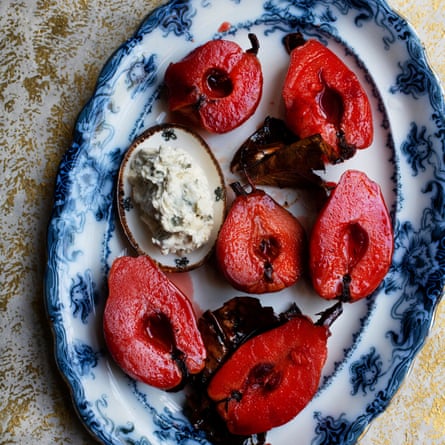
A little care is required when cooking quince. Once the peeled and halved fruits have been lowered into the syrup, adjust the heat so the liquid bubbles gently around them. If allowed to boil, the quince will collapse. You can turn them once as they cook with a large, preferably plastic, spoon but do so gently, so as not to tear their softening flesh. Once they are truly soft to the point of skewer, turn up the heat and watch the syrup carefully as it evaporates and becomes darker in colour. Remove from the heat once you have about 200ml of syrup left. The fruit may turn a glowing amber, some as red as beaujolais, others may stay pale gold. Let them cool in the syrup before lifting them very carefully from the pan and settling them on a plate or dish, moistened with a little of their syrup.
Serves 4
caster sugar 100g
water 1.5 litre
quince 4
lemon juice of 1
gorgonzola 350g
double cream 150g
Bring the sugar and water to the boil in a large, deep pan. Peel the quince and cut them in half from stalk to base rubbing them with a little lemon juice as you go. (Cutting a rock-hard quince in half requires a lot of pressure and a heavy cook’s knife. I’m sure you don’t need me to remind you to take care.) Squeeze the lemon juice into the sugar syrup, add the quince and lower the temperature to a simmer.
Continue cooking until the quince are tender to the point of a knife. This can take anything from 25-40 minutes (I have known a few batches take even longer), so keep testing them with a skewer. Check their progress regularly. They should be soft enough to pierce effortlessly yet still retain their shape. Turn up the heat and bubble till the juice has reduced and is starting to thicken – like runny jam. Remove from the heat and let them cool in their syrup.
Put the blue cheese in a bowl and cream lightly with a spoon. Whip the cream till it starts to thicken – it should be barely stiff enough to hold a shape – then stir gently into the cheese.
Remove the quince from their syrup with a draining spoon and transfer to plates or shallow bowls. Spoon the cheese filling on top of the fruits or offer separately, for those who wish.
Mincemeat baklava

Layers of crackling pastry as thin as a butterfly’s wing, and thick, sweet mincemeat – I like to offer this in small squares, tiny festive sweetmeats with which to end a long, celebratory dinner. They also work as something to pass around with coffee during the day.
This is one of those endlessly useful recipes that can turn up as an alternative to traditional, individual mince pies, or in larger slices as a dessert, for which you might like to make a jug of vanilla custard. The tray of uncut pastries will keep well in foil or an airtight tin for a couple of days, to slice as needed. A cut-and-come-again mince pie.
Once defrosted – which takes but a few minutes – the pastry will start to dry out rather quickly, so it is worth keeping a lightly moistened tea towel to hand to cover the sheets of pastry as you work. Brush each sheet generously with the melted butter as you go to help keep them crisp and separate as they bake. Get the lemon syrup on pretty much as soon as the baklava come from the oven.
Makes 20 small squares
frozen filo pastry 10 sheets
butter 150g
mincemeat 750g
walnut halves 150g
shelled pistachios 80g
ground almonds 125g
To finish
honey 3 tbsp
lemon juice of ½
shelled pistachios 3 tbsp
You will need a 30cm x 20cm baking tin.
Defrost the filo pastry. Melt the butter in a small pan and set aside.
Preheat the oven to 160C fan/gas mark 4. Put the mincemeat in a mixing bowl. Finely chop the walnuts and the pistachios. If you do this in a food processor, make sure you don’t grind too finely – the texture should be quite rough and nubbly. Add them to the mincemeat together with the ground almonds.
Place a sheet of filo pastry in the base of the baking tin and brush it with some of the butter. Follow this with another four sheets, buttering generously between each layer.
Spoon the filling over the pastry and lightly smooth the surface. Place the remaining sheets of filo on top, again buttering between each. Trim any overhanging pastry.
Score the surface layers of pastry with a large, sharp knife in a lattice fashion, each cut about 3cm wide (I do 6 each way). Bake for 40-45 minutes till crisp and deep gold.
Put the honey and lemon into a small saucepan and bring to the boil. As the pastry comes from the oven pour the mixture over the surface, then scatter with pistachios and leave to cool. Store in an airtight tin.
Courtesy: theguardian



